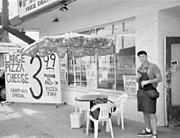AT THE CORNER of Martin Luther King Jr. Way and Othello Street in southeast Seattle, all the forces transforming the Rainier Valley are bearing down on one little commercial strip. And to pizza man Joe Bernstein that feels like a poke in the eye.
“It took balls to be here 10 years ago,” says Bernstein, whose shop backs up against the once-grim public housing project known as Holly Park. “We were one of the few businesses that would deliver in the Valley. We gave jobs to people on welfare, who couldn’t read, who’d never held a job. People called us fools for opening up here. Is this how I’m going to be thanked by the city?”
Bernstein’s pizza joint happens to sit at the intersection—literally—of several massive urban planning initiatives intended to morph MLK from a scruffy, haphazard thoroughfare dotted with low-slung apartments and auto body shops into a government-funded exemplar of enlightened urban design.
Sound Transit plans to run its light-rail trains down the center of MLK and will construct one of three street-level stations just north of Othello. City planners, who see the arrival of light rail as a chance to create denser “transit-oriented development,” are imposing new zoning codes in the blocks surrounding the stations to require pedestrian-friendly, multistory buildings—as opposed to Burger Kings fronted by parking lots. At Othello and MLK, city officials want to move “from an auto-dependent crossroads to a mixed-use town center.”
At the same time, the Seattle Housing Authority, a public agency separate from city government, is in the midst of a massive redevelopment of Holly Park. The third phase of this project will demolish some 36 acres of dilapidated duplexes along MLK and Othello and rebuild them in “urban village” row house style. As part of the plan, SHA intends to branch out from the subsidized housing biz to create four- or five-story, mixed-use buildings, with retail shops on the ground floor and condos up above.
To do this, SHA will have to buy up the sliver of land presently occupied by Bernstein and a handful of other merchants. Al Levine, SHA’s development director, describes the spot as “a pivotal location,” the “entryway” to Holly Park. “It’s a prime corner connected to the train,” he says, “and critical to successfully developing Phase III. We want to build a great neighborhood, and we think that corner can be improved.”
THE OTHELLO STRIP is like a micro Rainbow Coalition. An African-American woman owns the espresso stand, a Korean family runs the teriyaki joint, a Vietnamese immigrant operates a pawn business, a Laotian sells videos and gifts, and the second generation of a white family owns the towing company a few yards south. Bernstein, a former New Yorker, runs the Pizza Time franchise with his father. Their building owner, a Vietnamese man who goes by the name of Boon, keeps a couple dozen junker cars stored in back, purchased cheap from the towing company next door.
At a meeting with the corner’s merchants last month, Levine told them SHA “would like to start obtaining the property as soon as possible” and hopes to begin demolition within two years.
“That’s fine for you. You get a paycheck,” groused one participant.
Joyce, the espresso stand owner (who did not want her last name published), complained, “There’s no money for surviving until all this is finished. No one’s there with a zero-down loan to make sure everything’s OK because of what the city does to you.” After the new construction, she worries, “If we can’t afford it, then we’re out and Starbucks is in.” But Al Levine says SHA is actively seeking out money to assist the businesses and may make some effort to return them to their old locations. The agency’s goal is “to minimize or eliminate lag time” between when the businesses get the boot and when they have someplace new to open up.
Bernstein is extremely distrustful of the agency. “Most of the people here can’t speak much English,” Bernstein says of his neighbors. “I can. I know when I’m being screwed.” He’s particularly galled at the idea of SHA soon becoming his landlord. “That’s unbelievable,” he says.
With Sound Transit scheduled to knock out hundreds of structures to make room for light rail, the displacement of small merchants is “an issue throughout the Valley,” Levine observes. He hopes Othello businesses will be able to take advantage of the $50 million “Community Development Fund” that Sound Transit has pledged for areas in the Valley affected by light rail. But the fate of that fund remains extremely hazy for the moment. No actual money has been set aside for it, nor has any source of money even been identified. The Rainier Valley Transit Advisory Council, a community group allied with Sound Transit, is just now initiating a discussion of how the fund would operate and who would get access to the money. Council head Diane Davies says it will likely be well into next year before the fund is in business.
Levine remains confident that “we can solve all these problems and come up with something wonderful.” His appraisers were out at the Othello corner just last week, sizing up the properties to determine their market value. Bernstein says his landlord, Boon, chased the appraiser off, asking that she come back in a few days. Jokes Bernstein: “Now he’s probably going to repaint the place!”








